Adaptive Model Predictive Control for Mobile Robots with Localization Fluctuation Estimation
Abstract
1. Introduction
- (1)
- Integrating variance and information entropy—an enhanced localization fluctuation estimation method based on fuzzy logic rules is proposed to improve the accuracy of the fluctuation assessment.
- (2)
- A modified kinematics model with external disturbance using the Taylor expansion-based linearization is established, which is convenient for controller design under localization fluctuations.
- (3)
- An improved MPC with an adaptive adjustment of predictive step size related to localization fluctuation is proposed, which ensures the stability of the control system in dynamic scenes.
- (4)
- The proposed method has been tested in real dynamic scenarios and compared with mainstream methods, and its effectiveness has been demonstrated.
2. Related Works
2.1. Localization Fluctuation Estimation
2.2. Mobile Robot Control
3. System Modelling and Problem Formulation
3.1. System Modelling
3.2. Localization Problem Formulation
4. Localization Fluctuations Estimation
5. Adaptive MPC Considering Localization Fluctuation
6. Experimental Validations
6.1. Experimental Implementation
6.2. Experimental Results and Discussions
6.2.1. Experimental Results of Localization Fluctuation Estimation
6.2.2. Experimental Results of Adaptive MPC
7. Conclusions and Outlook
Author Contributions
Funding
Institutional Review Board Statement
Informed Consent Statement
Data Availability Statement
Conflicts of Interest
Notations and Abbreviations
| Notations/Abbreviations | Descriptions |
| SMC | sliding mode control |
| MPC | model predictive control |
| cost function | |
| Prediction/control horizon | |
| weight matrix | |
| linear velocity | |
| angular velocity | |
| , | coefficient matrices |
| higher order remainder of the Taylor expansion | |
| estimated localization fluctuation value | |
| adjustment coefficient | |
| minimum adjustment coefficient |
References
- Rubio, F.; Valero, F.; Llopis-Albert, C. A review of mobile robots: Concepts, methods, theoretical framework, and applications. Int. J. Adv. Robot. Syst. 2019, 16, 1729881419839596. [Google Scholar] [CrossRef]
- Skoczeń, M.; Ochman, M.; Spyra, K.; Nikodem, M.; Krata, D.; Panek, M.; Pawłowski, A. Obstacle detection system for agricultural mobile robot application using RGB-D cameras. Sensors 2021, 21, 5292. [Google Scholar] [CrossRef] [PubMed]
- Meng, J.; Wang, S.; Jiang, L.; Xie, Y.; Zheng, S.; Wu, H. Robust lateral stabilization control of in-wheel-motor-driven mobile robots via active disturbance suppression approach. Sensors 2020, 20, 5238. [Google Scholar] [CrossRef]
- Higgins, J.; Bezzo, N. Negotiating visibility for safe autonomous navigation in occluding and uncertain environments. IEEE Robot. Autom. Lett. 2021, 6, 4409–4416. [Google Scholar] [CrossRef]
- Zhang, X.; Xie, Y.; Jiang, L.; Li, G.; Meng, J.; Huang, Y. Fault-tolerant dynamic control of a four-wheel redundantly-actuated mobile robot. IEEE Access 2019, 7, 157909–157921. [Google Scholar] [CrossRef]
- Jiang, L.; Wang, S.; Xie, Y.; Xie, S.; Zheng, S.; Meng, J.; Ding, H. Decoupled Fractional Supertwisting Stabilization of Interconnected Mobile Robot Under Harsh Terrain Conditions. IEEE Trans. Ind. Electron. 2021, 69, 8178–8189. [Google Scholar] [CrossRef]
- Tzafestas, S.G. Mobile robot control and navigation: A global overview. J. Intell. Robot. Syst. 2018, 91, 35–58. [Google Scholar] [CrossRef]
- Jiang, L.; Wang, S.; Xie, Y.; Xie, S.Q.; Zheng, S.; Meng, J. Fractional robust finite time control of four-wheel-steering mobile robots subject to serious time-varying perturbations. Mech. Mach. Theory 2022, 169, 104634. [Google Scholar] [CrossRef]
- Meng, J.; Wan, L.; Wang, S.; Jiang, L.; Li, G.; Wu, L.; Xie, Y. Efficient and reliable LiDAR-based global localization of mobile robots using multiscale/resolution maps. IEEE Trans. Instrum. Meas. 2021, 70, 1–15. [Google Scholar] [CrossRef]
- Zhang, M.; Liu, X.; Xu, D.; Cao, Z.; Yu, J. Vision-based target-following guider for mobile robot. IEEE Trans. Ind. Electron. 2019, 66, 9360–9371. [Google Scholar] [CrossRef]
- Meng, J.; Wang, S.; Xie, Y.; Li, G.; Zhang, X.; Jiang, L.; Liu, C. A safe and efficient LIDAR-based navigation system for 4WS4WD mobile manipulators in manufacturing plants. Meas. Sci. Technol. 2021, 32, 045203. [Google Scholar] [CrossRef]
- Mur-Artal, R.; Montiel, J.M.M.; Tardos, J.D. ORB-SLAM: A versatile and accurate monocular SLAM system. IEEE Trans. Robot. 2015, 31, 1147–1163. [Google Scholar] [CrossRef]
- Shan, T.; Englot, B. Lego-loam: Lightweight and ground-optimized lidar odometry and mapping on variable terrain. In Proceedings of the 2018 IEEE/RSJ International Conference on Intelligent Robots and Systems (IROS), Madrid, Spain, 1–5 October 2018; pp. 4758–4765. [Google Scholar]
- Chung, M.-A.; Lin, C.-W. An improved localization of mobile robotic system based on AMCL algorithm. IEEE Sens. J. 2021, 22, 900–908. [Google Scholar] [CrossRef]
- Li, G.; Meng, J.; Xie, Y.; Zhang, X.; Huang, Y.; Jiang, L.; Liu, C. Reliable and fast localization in ambiguous environments using ambiguity grid map. Sensors 2019, 19, 3331. [Google Scholar] [CrossRef] [PubMed]
- Meng, J.; Wang, S.; Jiang, L.; Hu, Z.; Xie, Y. Accurate and Efficient Self-localization of AGV Relying on Trusted Area Information in Dynamic Industrial Scene. In IEEE Transactions on Vehicular Technology; IEEE: Manhattan, NY, USA, 2023. [Google Scholar]
- Ge, G.; Zhang, Y.; Wang, W.; Jiang, Q.; Hu, L.; Wang, Y. Text-MCL: Autonomous mobile robot localization in similar environment using text-level semantic information. Machines 2022, 10, 169. [Google Scholar] [CrossRef]
- Zhang, L.; Zapata, R.; Lepinay, P. Self-adaptive Monte Carlo localization for mobile robots using range finders. Robotica 2012, 30, 229–244. [Google Scholar] [CrossRef]
- Sun, H.; Wang, S.; Meng, J.; Liu, Y.; Xie, Y. Accurate Pose Tracking of Mobile Robot Using Entropy-based TrimICP in Dynamic Environment. In Proceedings of the IECON 2022–48th Annual Conference of the IEEE Industrial Electronics Society, Brussels, Belgium, 17–20 October 2022; pp. 1–6. [Google Scholar]
- Bukhori, I.; Ismail, Z.H. Detection of kidnapped robot problem in monte carlo localization based on the natural displacement of the robot. Int. J. Adv. Robot. Syst. 2017, 14, 1729881417717469. [Google Scholar] [CrossRef]
- Meng, J.; Wang, S.; Li, G.; Jiang, L.; Zhang, X.; Liu, C.; Xie, Y. Iterative-learning error compensation for autonomous parking of mobile manipulator in harsh industrial environment. Robot. Comput.-Integr. Manuf. 2021, 68, 102077. [Google Scholar] [CrossRef]
- Toomaj, A.; Di Crescenzo, A. Connections between weighted generalized cumulative residual entropy and variance. Mathematics 2020, 8, 1072. [Google Scholar] [CrossRef]
- Zidek, J.V.; Van Eeden, C. Uncertainty, entropy, variance and the effect of partial information. Lect. Notes-Monogr. Ser. 2003, 42, 155–167. [Google Scholar]
- Chen, Y.; Li, Z.; Kong, H.; Ke, F. Model predictive tracking control of nonholonomic mobile robots with coupled input constraints and unknown dynamics. IEEE Trans. Ind. Inform. 2018, 15, 3196–3205. [Google Scholar] [CrossRef]
- Singh, P.; Nandanwar, A.; Behera, L.; Verma, N.K.; Nahavandi, S. Uncertainty compensator and fault estimator-based exponential supertwisting sliding-mode controller for a mobile robot. In IEEE Transactions on Cybernetics; IEEE: Manhattan, NY, USA, 2021. [Google Scholar]
- Ren, C.; Li, X.; Yang, X.; Ma, S. Extended state observer-based sliding mode control of an omnidirectional mobile robot with friction compensation. IEEE Trans. Ind. Electron. 2019, 66, 9480–9489. [Google Scholar] [CrossRef]
- Liu, X.; Wang, W.; Li, X.; Liu, F.; He, Z.; Yao, Y.; Ruan, H.; Zhang, T. MPC-based high-speed trajectory tracking for 4WIS robot. ISA Trans. 2022, 123, 413–424. [Google Scholar] [CrossRef] [PubMed]
- Dai, L.; Lu, Y.; Xie, H.; Sun, Z.; Xia, Y. Robust tracking model predictive control with quadratic robustness constraint for mobile robots with incremental input constraints. IEEE Trans. Ind. Electron. 2020, 68, 9789–9799. [Google Scholar] [CrossRef]
- Sun, Z.; Xia, Y.; Dai, L.; Liu, K.; Ma, D. Disturbance rejection MPC for tracking of wheeled mobile robot. IEEE/ASME Trans. Mechatron. 2017, 22, 2576–2587. [Google Scholar] [CrossRef]
- Jiang, L.; Xie, Y.; Jiang, Z.; Meng, J.; Li, W. Adaptive model predictive control of mobile robot with local path refitting. In Proceedings of the 2022 IEEE 17th Conference on Industrial Electronics and Applications (ICIEA), Chengdu, China, 16–19 December 2022; pp. 596–601. [Google Scholar]
- Li, J.; Wang, J.; Peng, H.; Hu, Y.; Su, H. Fuzzy-torque approximation-enhanced sliding mode control for lateral stability of mobile robot. IEEE Trans. Syst. Man Cybern. Syst. 2021, 52, 2491–2500. [Google Scholar] [CrossRef]
- Ding, T.; Zhang, Y.; Ma, G.; Cao, Z.; Zhao, X.; Tao, B. Trajectory tracking of redundantly actuated mobile robot by MPC velocity control under steering strategy constraint. Mechatronics 2022, 84, 102779. [Google Scholar] [CrossRef]
- Zhang, Y.; Zhao, X.; Tao, B.; Ding, H. Point stabilization of nonholonomic mobile robot by Bézier smooth subline constraint nonlinear model predictive control. IEEE/ASME Trans. Mechatron. 2020, 26, 990–1001. [Google Scholar] [CrossRef]
- Hu, Y.; Su, H.; Fu, J.; Karimi, H.R.; Ferrigno, G.; De Momi, E.; Knoll, A. Nonlinear model predictive control for mobile medical robot using neural optimization. IEEE Trans. Ind. Electron. 2020, 68, 12636–12645. [Google Scholar] [CrossRef]
- Taheri, H.; Zhao, C.X. Omnidirectional mobile robots, mechanisms and navigation approaches. Mech. Mach. Theory 2020, 153, 103958. [Google Scholar] [CrossRef]
- Wang, J.; Luo, Z.; Wang, Y.; Yang, B.; Assadian, F. Coordination control of differential drive assist steering and vehicle stability control for four-wheel-independent-drive EV. IEEE Trans. Veh. Technol. 2018, 67, 11453–11467. [Google Scholar] [CrossRef]
- Cui, M.; Liu, W.; Liu, H.; Jiang, H.; Wang, Z. Extended state observer-based adaptive sliding mode control of differential-driving mobile robot with uncertainties. Nonlinear Dyn. 2016, 83, 667–683. [Google Scholar] [CrossRef]
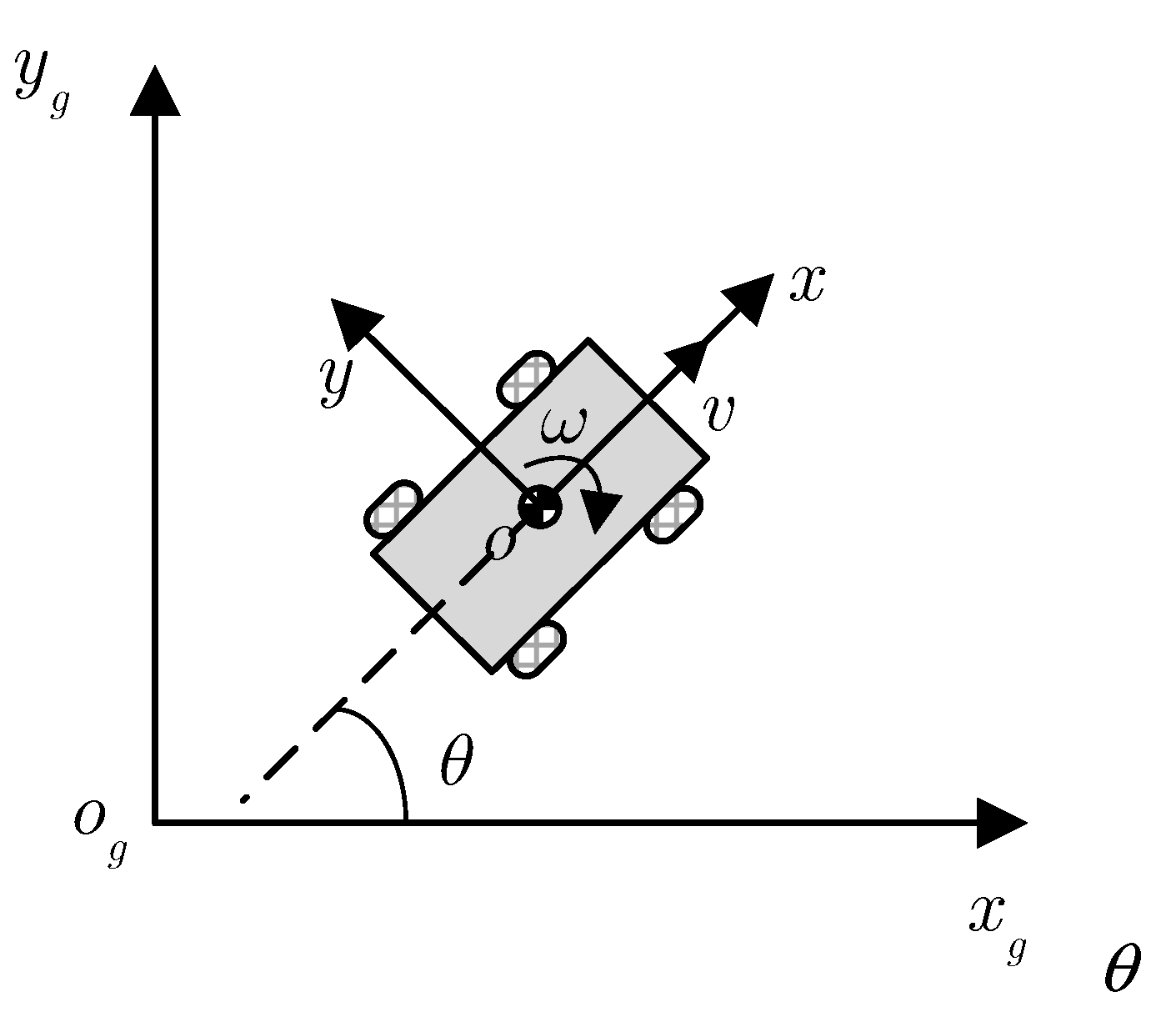

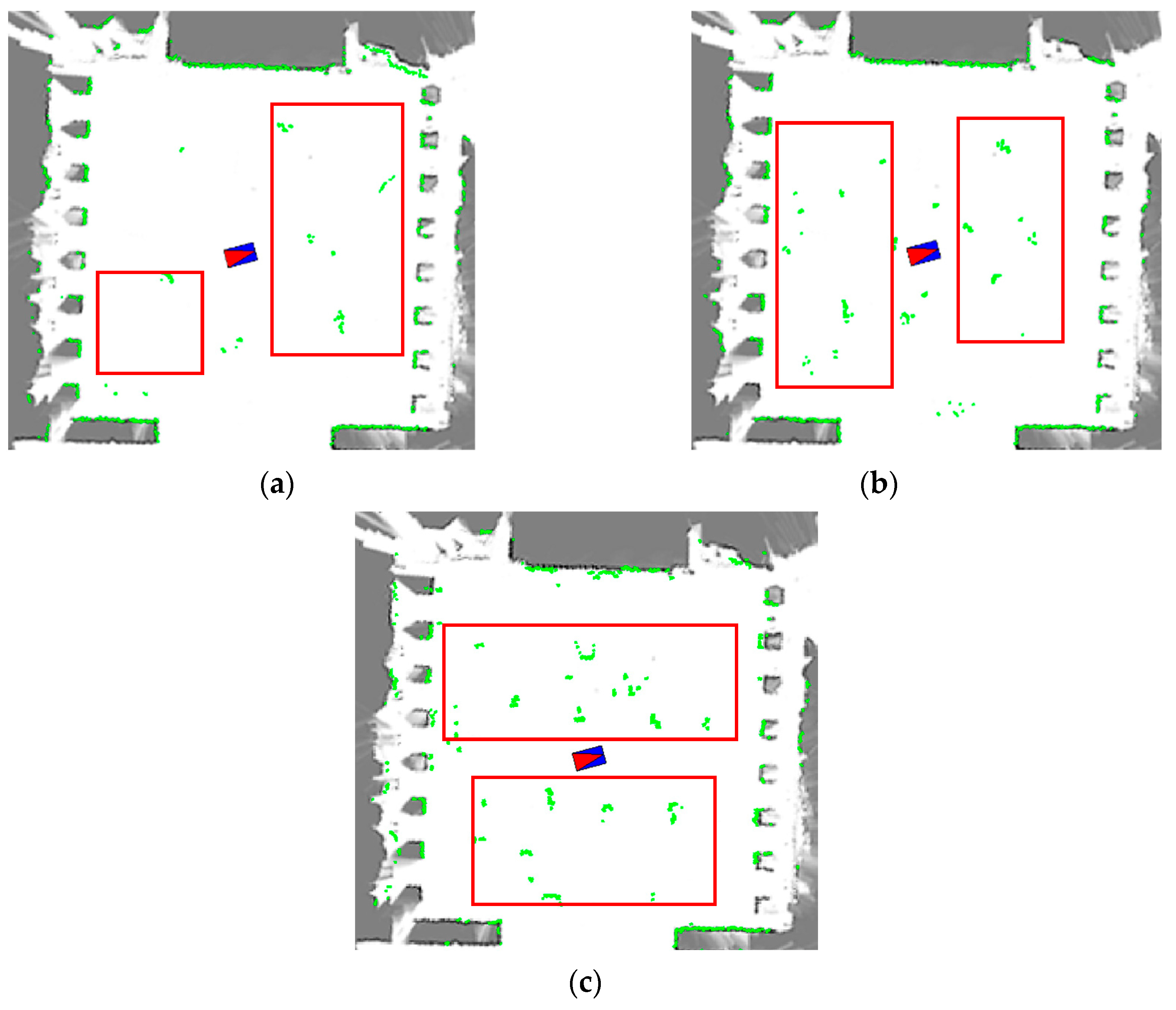
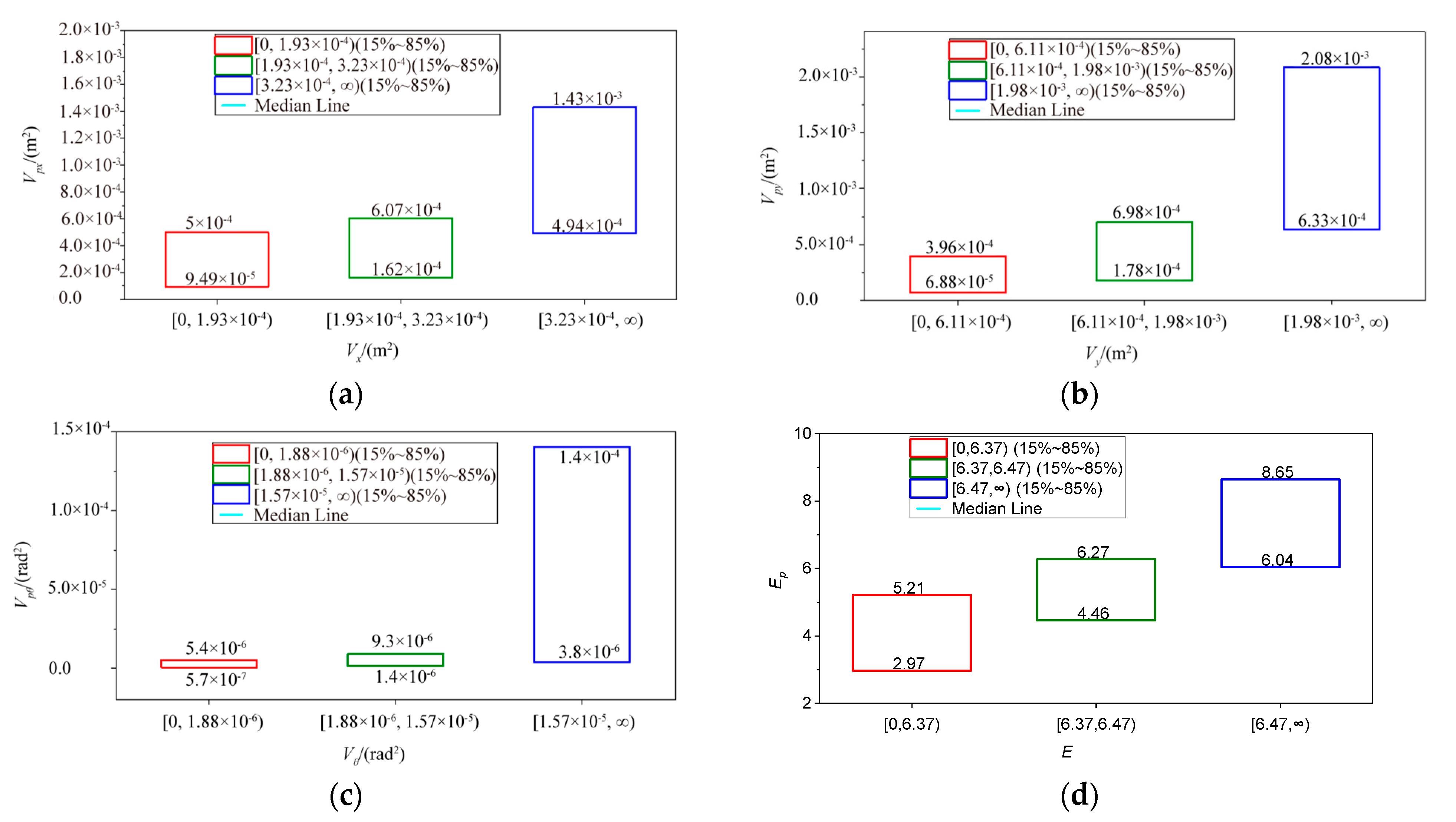

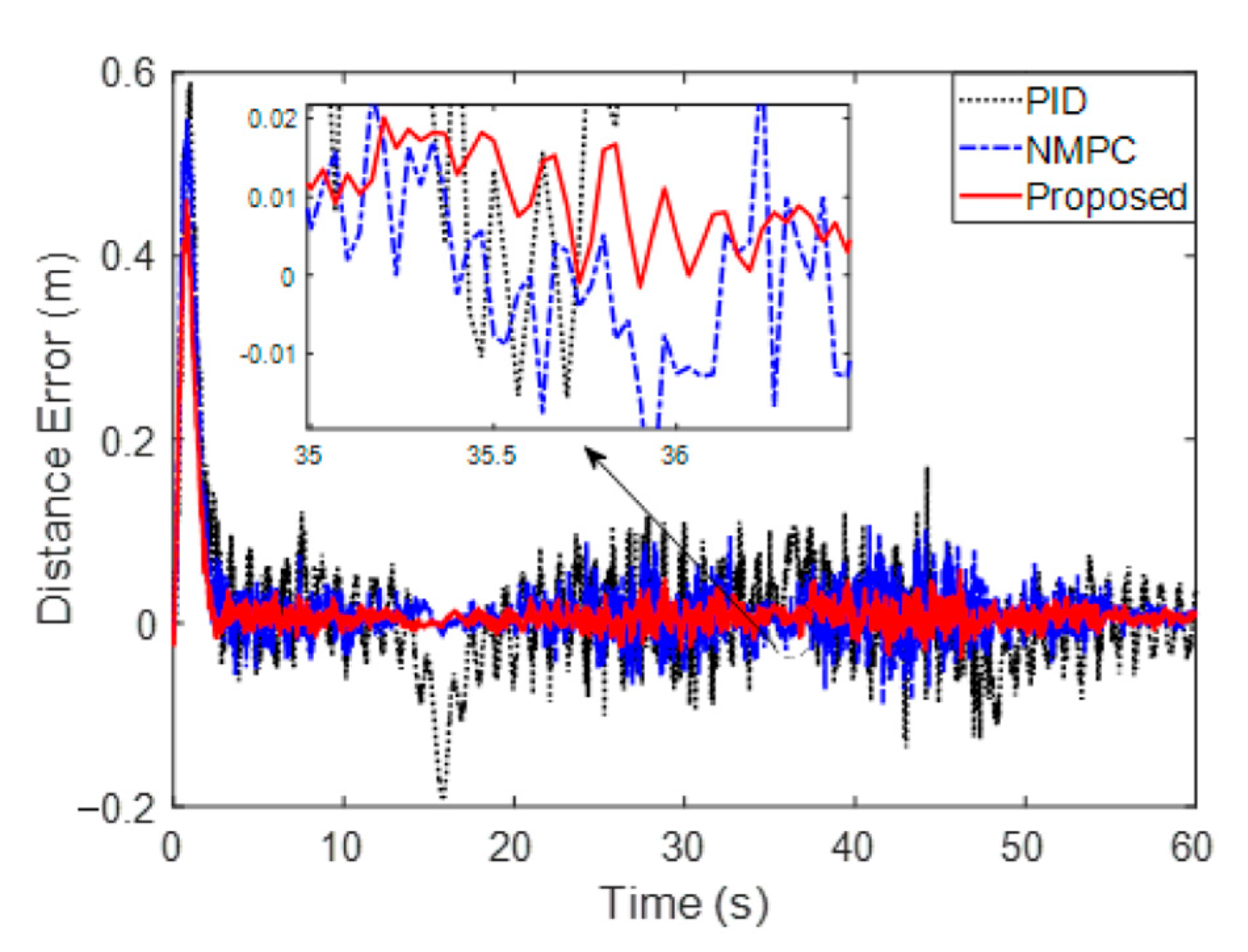
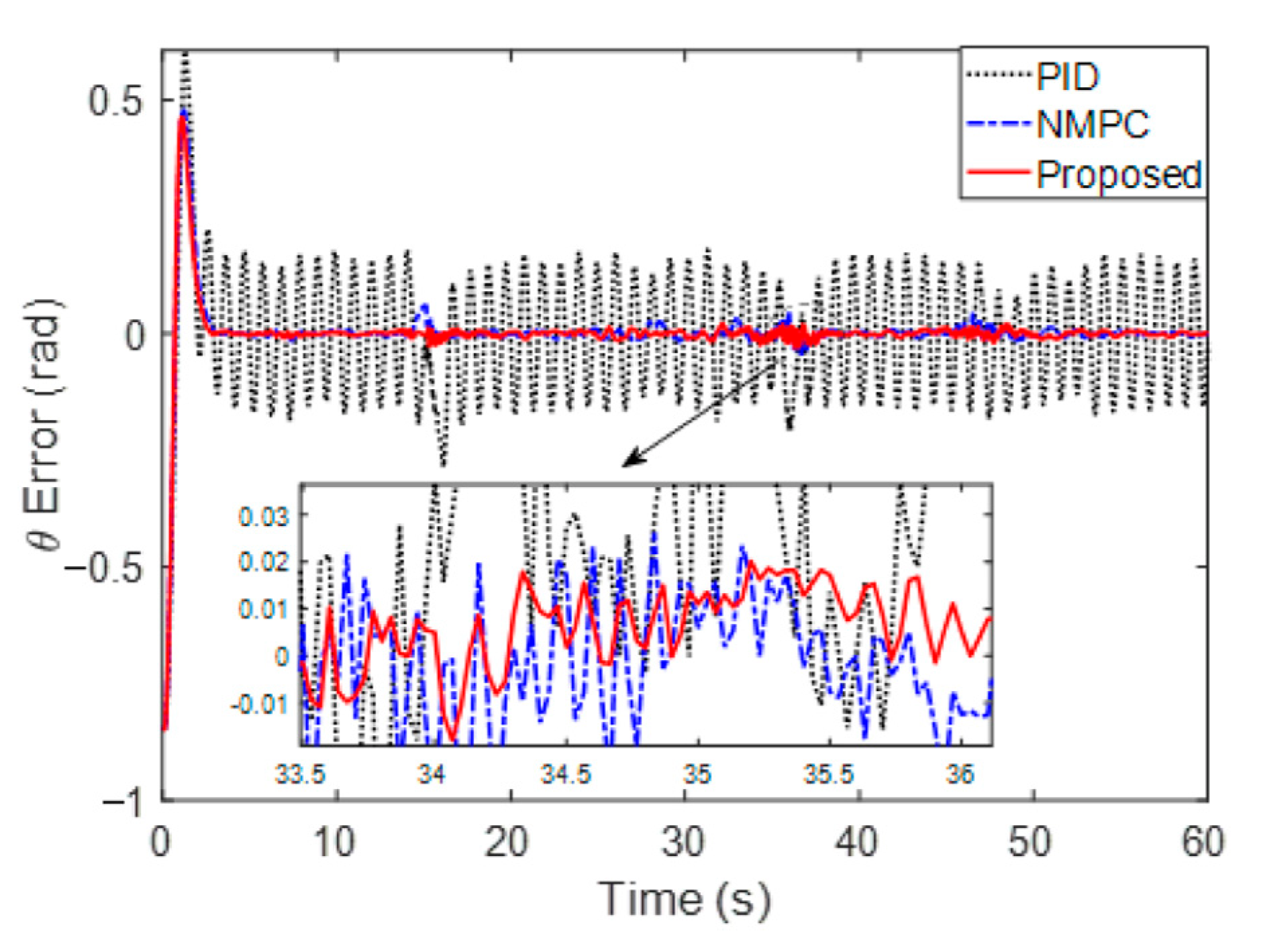
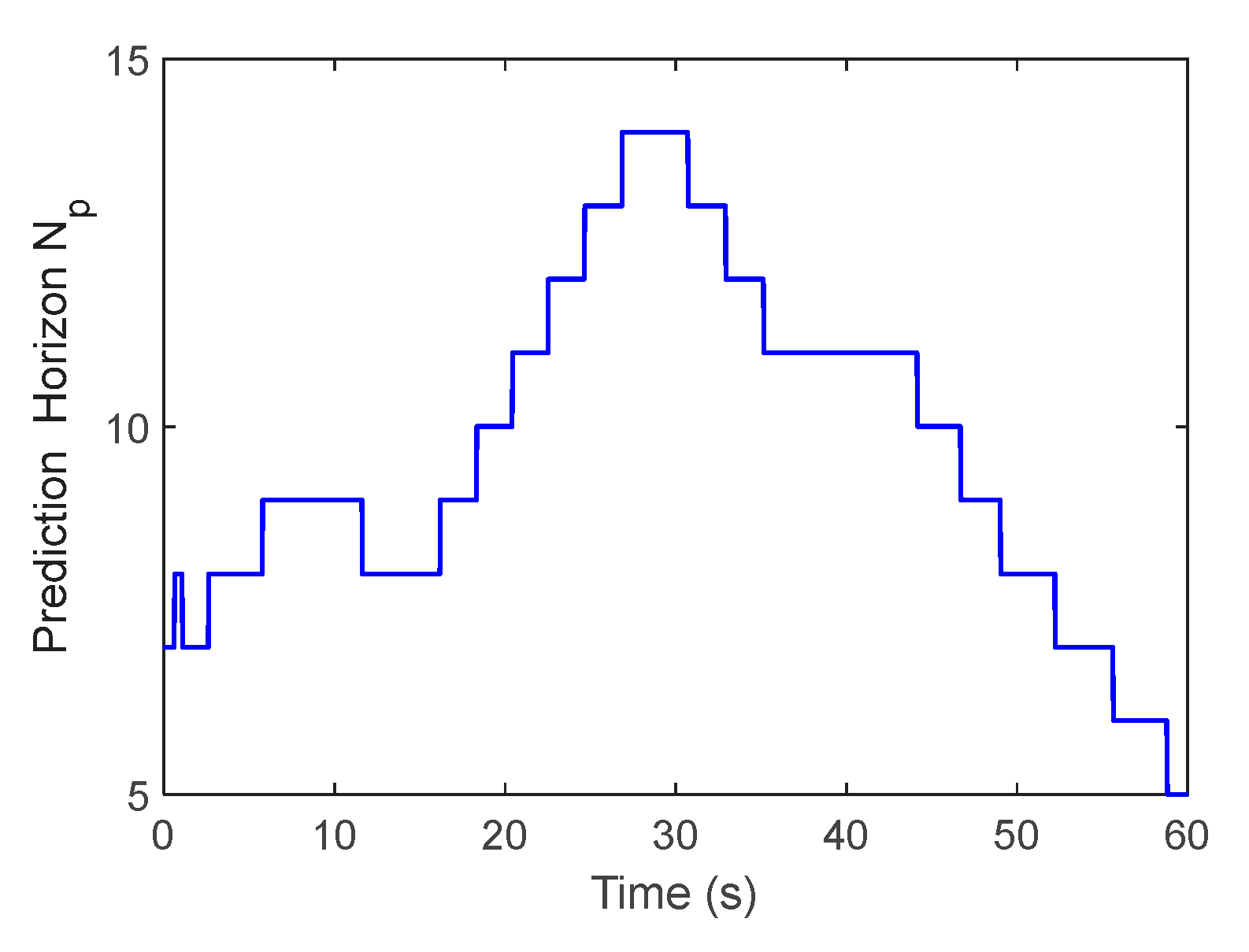
| Low Dynamic Scene | Medium Dynamic Scene | High Dynamic Scene | |||||||||||
|---|---|---|---|---|---|---|---|---|---|---|---|---|---|
| Vx/(m2) | Vy/(m2) | Vθ/(rad2) | E | Vx/(m2) | Vy(m2) | Vθ/(rad2) | E | Vx/(m2) | Vy(m2) | Vθ/(rad2) | E | ||
| Site 1 | 1.24 × 10−4 | 3.23 × 10−4 | 1.53 × 10−6 | 6.33 | 2.19 × 10−4 | 8.55 × 10−4 | 1.93 × 10−6 | 6.41 | 4.67 × 10−4 | 6.28 × 10−3 | 7.48 × 10−5 | 6.56 | |
| Site 2 | 1.62 × 10−4 | 5.71 × 10−4 | 5.57 × 10−7 | 6.32 | 2.09 × 10−4 | 7.45 × 10−4 | 1.04 × 10−6 | 6.43 | 4.33 × 10−4 | 1.26 × 10−3 | 2.70 × 10−6 | 6.51 | |
| Site 3 | 1.80 × 10−4 | 2.63 × 10−4 | 1.48 × 10−6 | 6.37 | 2.66 × 10−4 | 9.09 × 10−4 | 4.76 × 10−6 | 6.39 | 3.45 × 10−4 | 1.83 × 10−3 | 8.97 × 10−6 | 6.54 | |
| Range | Range1: | Range2: | Range3: | ||||||
| /(m2) | 7.03 × 10−4 | 3.06 × 10−4 | 5.05 × 10−4 | 1.17 × 10−2 | 3.54 × 10−4 | 3.92 × 10−4 | 1.18 × 10−1 | 9.10 × 10−4 | 5.84 × 10−4 |
| 98 lines of | |||||||||
| 4.76 × 10−4 | 3.37 × 10−4 | 4.57 × 10−4 | 3.96 × 10−4 | 2.88 × 10−4 | 1.49 × 10−4 | 1.39 × 10−3 | 7.85 × 10−4 | 8.83 × 10−4 | |
| Range | range1: | range2: | range3: | ||||||
| /(m2) | 8.01 × 10−4 | 4.08 × 10−4 | 1.45 × 10−4 | 2.61 × 10−2 | 3.24 × 10−4 | 9.01 × 10−4 | 2.82 × 10−1 | 1.20 × 10−2 | 1.37 × 10−3 |
| 98 lines of | |||||||||
| 2.75 × 10−4 | 1.86 × 10−4 | 2.69 × 10−4 | 2.18 × 10−4 | 3.21 × 10−4 | 1.40 × 10−4 | 1.12 × 10−3 | 8.20 × 10−4 | 1.14 × 10−3 | |
| Range | range1: | range2: | range3: | ||||||
| /(rad2) | 4.59 × 10−6 | 1.03 × 10−6 | 3.50 × 10−7 | 3.14 × 10−4 | 8.30 × 10−7 | 9.34 × 10−7 | 5.13 × 10−3 | 1.20 × 10−4 | 1.99 × 10−5 |
| 98 lines of | |||||||||
| 7.66 × 10−6 | 2.45 × 10−6 | 3.01 × 10−6 | 9.88 × 10−7 | 2.12 × 10−6 | 1.69 × 10−6 | 1.09 × 10−4 | 2.11 × 10−5 | 5.95 × 10−5 | |
| Range | range1: 0.00 ≤ E <6.37 | range2: 6.37 ≤ E <6.47 | range3: 6.47 ≤ E | ||||||
| 6.22 | 2.51 | 5.18 | 5.05 | 6.30 | 5.00 | 1.11 | 8.85 | 7.79 | |
| 98 lines of | |||||||||
| 4.88 | 5.03 | 4.07 | 5.73 | 5.39 | 5.19 | 7.29 | 7.98 | 7.94 | |
Disclaimer/Publisher’s Note: The statements, opinions and data contained in all publications are solely those of the individual author(s) and contributor(s) and not of MDPI and/or the editor(s). MDPI and/or the editor(s) disclaim responsibility for any injury to people or property resulting from any ideas, methods, instructions or products referred to in the content. |
© 2023 by the authors. Licensee MDPI, Basel, Switzerland. This article is an open access article distributed under the terms and conditions of the Creative Commons Attribution (CC BY) license (https://creativecommons.org/licenses/by/4.0/).
Share and Cite
Meng, J.; Xiao, H.; Jiang, L.; Hu, Z.; Jiang, L.; Jiang, N. Adaptive Model Predictive Control for Mobile Robots with Localization Fluctuation Estimation. Sensors 2023, 23, 2501. https://doi.org/10.3390/s23052501
Meng J, Xiao H, Jiang L, Hu Z, Jiang L, Jiang N. Adaptive Model Predictive Control for Mobile Robots with Localization Fluctuation Estimation. Sensors. 2023; 23(5):2501. https://doi.org/10.3390/s23052501
Chicago/Turabian StyleMeng, Jie, Hanbiao Xiao, Liyu Jiang, Zhaozheng Hu, Liquan Jiang, and Ning Jiang. 2023. "Adaptive Model Predictive Control for Mobile Robots with Localization Fluctuation Estimation" Sensors 23, no. 5: 2501. https://doi.org/10.3390/s23052501
APA StyleMeng, J., Xiao, H., Jiang, L., Hu, Z., Jiang, L., & Jiang, N. (2023). Adaptive Model Predictive Control for Mobile Robots with Localization Fluctuation Estimation. Sensors, 23(5), 2501. https://doi.org/10.3390/s23052501






